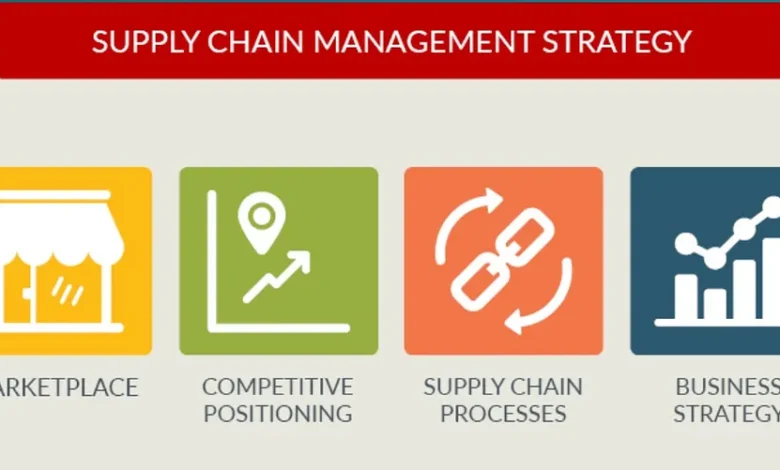Crafting an Effective Supply Chain Strategy

In the competitive landscape of modern business, an effective supply chain strategy is crucial for ensuring operational efficiency, customer satisfaction, and overall profitability. This comprehensive guide explores the key elements of a supply chain strategy, its importance, and how businesses can develop and implement a robust strategy to stay ahead in their industries.
Understanding Supply Chain Strategy
A supply chain strategy involves the planning and management of all activities involved in sourcing, procurement, conversion, and logistics management. It encompasses the coordination and collaboration with channel partners, which can be suppliers, intermediaries, third-party service providers, and customers. The objective is to streamline and optimize the supply chain to ensure the seamless flow of goods, information, and finances.
Key Components: A comprehensive supply chain strategy includes several key components:
- Supply Chain Design: This involves designing the overall structure of the supply chain, including the selection of suppliers, manufacturing locations, distribution centers, and logistics networks.
- Inventory Management: Effective inventory management ensures that the right amount of stock is maintained to meet demand without overstocking or stockouts.
- Demand Planning: Forecasting customer demand accurately to align production and inventory levels.
- Logistics and Distribution: Managing the transportation and delivery of goods from suppliers to customers in the most efficient manner.
- Supplier Relationship Management: Building strong relationships with suppliers to ensure quality, reliability, and cost-effectiveness.
The Importance of a Supply Chain Strategy
An effective supply chain strategy is vital for several reasons. It helps businesses manage risks, reduce costs, and improve service levels. Additionally, it provides a competitive advantage by enabling companies to respond swiftly to market changes and customer demands.
Risk Management: A well-defined supply chain strategy helps identify potential risks and develop mitigation plans. This includes diversifying suppliers, maintaining buffer stocks, and establishing contingency plans for disruptions such as natural disasters, geopolitical tensions, or supply chain bottlenecks.
Cost Reduction: By optimizing the supply chain, businesses can significantly reduce operational costs. This includes minimizing transportation costs through efficient routing, reducing inventory holding costs by improving demand forecasting, and negotiating better terms with suppliers.
Enhanced Service Levels: A robust supply chain strategy ensures that products are delivered to customers on time and in good condition. This improves customer satisfaction and loyalty, which is crucial for maintaining a competitive edge.
Developing a Supply Chain Strategy
Creating an effective supply chain strategy requires a deep understanding of the business’s objectives, market conditions, and internal capabilities. Here are the steps to develop a comprehensive supply chain strategy:
Assessing the Current Supply Chain: Begin by evaluating the current supply chain processes and performance. Identify strengths, weaknesses, and areas for improvement. This assessment should include a thorough analysis of supply chain costs, lead times, inventory levels, and service performance.
Setting Clear Objectives: Define the goals of the supply chain strategy in alignment with the overall business objectives. These goals could include reducing costs, improving delivery times, enhancing flexibility, or increasing customer satisfaction.
Analyzing Market Conditions: Understand the market dynamics, including customer expectations, competitor strategies, and emerging trends. This analysis helps in identifying opportunities and threats that could impact the supply chain.
Designing the Supply Chain Network: Based on the objectives and market analysis, design an optimal supply chain network. This includes selecting suppliers, manufacturing locations, and distribution centers. Consider factors such as proximity to key markets, cost structures, and the availability of resources.
Implementing Technology Solutions: Leverage advanced technologies to enhance supply chain visibility, efficiency, and responsiveness. This includes implementing ERP systems, supply chain management software, and IoT devices for real-time tracking and monitoring.
Building Strong Supplier Relationships: Develop collaborative relationships with key suppliers to ensure reliability, quality, and cost-effectiveness. This includes establishing long-term contracts, joint improvement initiatives, and transparent communication channels.
Implementing and Monitoring the Strategy
Once the supply chain strategy is developed, the next step is implementation. This involves aligning the organization’s processes, resources, and capabilities with the strategic objectives.
Change Management: Implementing a new supply chain strategy often requires significant changes in processes, systems, and organizational culture. Effective change management is crucial to ensure that all stakeholders are aligned and committed to the strategy.
Training and Development: Equip employees with the necessary skills and knowledge to execute the supply chain strategy. This includes training on new systems, processes, and best practices.
Performance Monitoring: Continuously monitor the performance of the supply chain against the defined objectives. Use key performance indicators (KPIs) such as lead times, order accuracy, inventory turnover, and cost savings to measure success.
Continuous Improvement: A supply chain strategy is not static; it needs to evolve with changing market conditions and business requirements. Regularly review and update the strategy to incorporate new technologies, processes, and insights.
Supply Chain Strategy in Practice
To illustrate the practical application of a supply chain strategy, consider the example of a global electronics manufacturer. The company aimed to reduce lead times and improve service levels while managing costs effectively.
Strategic Goals: The company set clear objectives, including reducing lead times by 20%, cutting transportation costs by 15%, and improving on-time delivery rates to 95%.
Supply Chain Network Design: The company redesigned its supply chain network by establishing regional distribution centers closer to key markets, reducing the reliance on long-haul transportation. They also diversified their supplier base to mitigate risks.
Technology Integration: By implementing an advanced supply chain management system, the company achieved real-time visibility into inventory levels, demand forecasts, and shipment statuses. This enabled proactive decision-making and improved coordination across the supply chain.
Supplier Collaboration: The company developed strategic partnerships with key suppliers, focusing on joint innovation and continuous improvement initiatives. This collaboration resulted in better quality control, cost savings, and enhanced supply chain resilience.
Conclusion
A well-crafted supply chain strategy is essential for businesses seeking to thrive in today’s complex and dynamic market environment. By understanding the key components, benefits, and development processes of a supply chain strategy, companies can optimize their operations, manage risks, and deliver superior value to their customers. As the business landscape continues to evolve, a flexible and robust supply chain strategy will remain a critical driver of success.




